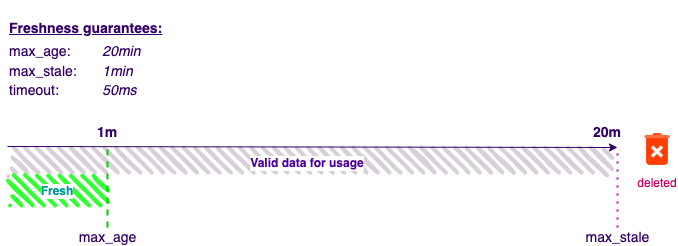Freshness Guarantees
Production systems expect strict service guarantees that ensures the quality of the service for the end-user.
To implement that, you should define a desired Service Layer Agreement for your features, and Raptor will build a customized implementation for you features that meet these guarantees.
Another way to look at it is to think of the Freshness Guarantees as a set of rules that defines what is the "current state" of the world.
Freshness definition
When creating the Feature or a Model Definition, you specify three important values: max_age, max_stale,
and timeout.

max_age- Is the age of a data that is considered fresh. When the data is fresh, we don't need to compute it again.max_stale- If we don't have a fresh value, we might use a stale value as a fallback, as long as it's not too stale(as defined in themax_stale.timeout- Is the maximum time that we can wait for the data to be computed. If the timeout is exceeded, we will either return a stale data(if we have it), or through an error.
How does it work?
Under the hood, Raptor configures the necessary data-sources, storage, and compute resources to ensure that your features meet the Freshness guarantees.
When a value is requested, Raptor:
- Check if we have a fresh value for the feature. If we do, return it.
- If the data we have is not fresh, but it's not past the max_stale yet, we will compute the data again, and return
it.
- If the data is computed before the
timeout, return it. - If the data is computed after the
timeout, return the stale data, and compute the data in the background for future usage.
- If the data is computed before the
- If we don't have a stale data, and the timeout is exceeded, return an error.
- Stale data past the
max_staleage is never returned. Instead, the Historian is recording it for future usage, and we delete it from the State.